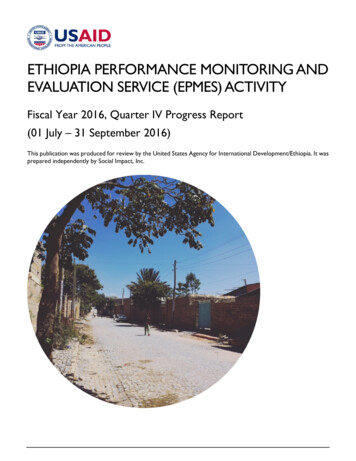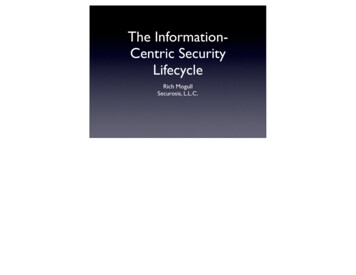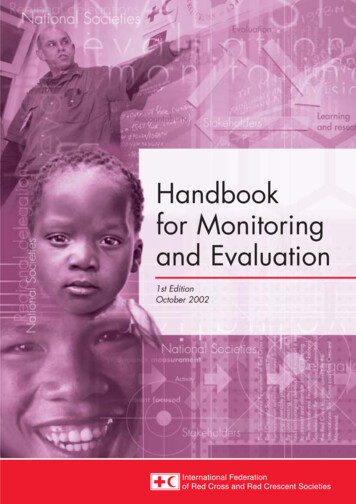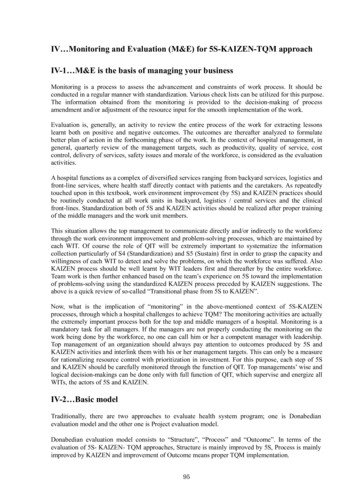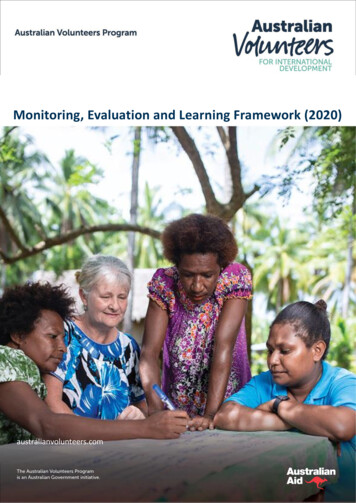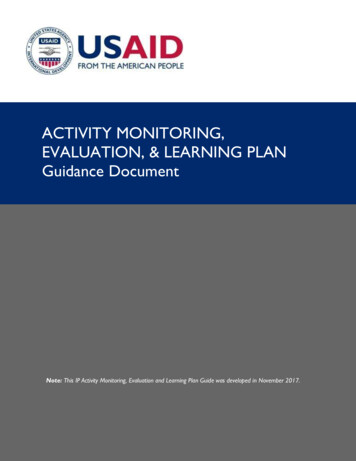
Transcription
ACTIVITY MONITORING,EVALUATION, & LEARNING PLANGuidance DocumentNote: This IP Activity Monitoring, Evaluation and Learning Plan Guide was developed in November 2017.July 20081
List of AbbreviationsADSAutomated Directives SystemAORAgreement Officer’s RepresentativeCDCSCountry Development Cooperation StrategyCIRSContext Indicator Reference SheetsCLACollaborating, Learning, and AdaptingCOPChief of PartyCORContract Officer’s RepresentativeDODevelopment ObjectiveDQAData Quality AssessmentDRCDemocratic Republic of the CongoHOHome OfficeIPImplementing PartnerIRIntermediate ResultLogframeLogical FrameworkMELMonitoring, Evaluation and LearningPIIPersonally Identifiable InformationPIRSPerformance Indicator Reference SheetPMPPerformance Management PlanPPRPerformance Plan and ReportRFResults FrameworkSOWStatement of WorkSTIPScience, Technology, Innovation and PartnershipsUSAIDUnited States Agency for International DevelopmentUSGUnited States GovernmentVEMSSVietnam Evaluation, Monitoring and Survey Services
Contents1.Introduction to the Guidelines . 22.Key Components of an Activity MEL Plan. 42.12.62.72.8Introduction . 4Activity Theory of Change and Logic Model . 4Monitoring Plan . 5Performance Monitoring . 5Context Monitoring . 7Cross-cutting Issues . 7Evaluation Plan. 8Internal Evaluations. 8Plans for Collaborating with External Evaluators . 8Learning Agenda . 9Overview . 92. Learning Agenda Development . 93. Important Tips . 11Data Management. 11Data Collection . 11Data Quality Assurance. 11Data Storage . 12Data Security. 12Data Analysis and Use . 12Roles, Responsibilities, and Schedule . 12Resources . 13Change Log . 133.Annex: Links to USAID Learning Lab Reference Materials. 142.22.32.42.5Activity MEL Plan Guidance DocumentPage 1 of 16
1. INTRODUCTION TO THE GUIDELINESThis guide provides detailed instructions and outlines practical steps for Implementation Partners (IPs)who will need to complete their Activity Monitoring, Evaluation and Learning (MEL) Plan in alignmentwith USAID standards stated in the How-To Note Supplements to the ADS.Before going into detail about development of Activity MEL Plans, IPs need to understand the key termsand related definitions that are used in this plan. These terms, as well as others used in the Activity MELPlan, can be found online at: https://www.usaid.gov/ads/policy/200/201.Key concepts:USAID CDCS (Country Development Cooperation Strategy): The strategy that defines aMission’s chosen country approach and provides a focal point of the broader context for projectsand activities. A CDCS presents expected results within a time-defined period, provides a commonvision and an organizing framework, and summarizes the status of the ongoing portfolio and howthat will be continued, updated, or revised to address new priorities, lessons learned, or changingcircumstances. The CDCS generally covers a five-year period. USAID/Vietnam’s CDCS can befound at https://www.usaid.gov/vietnam/cdcs.USAID Project: A set of complementary activities with an established timeline and budgetintended to achieve a discrete development result, often aligned with an Intermediate Result (IR) inthe USAID CDCS Results Framework. Taken together, a Mission’s suite of project designs providesthe operational plans for achieving the objectives of the CDCS. A USAID project is not animplementing mechanism; rather it is a planning and management framework under which severalactivities, or project sub-components, are funded and executed on an integrated basis to achieve anIntermediate Result (IR).USAID Activity: Per ADS 201 definitions section, p. 140: “An activity carries out an intervention,or set of interventions, typically through a contract, grant, or agreement with another U.S.Government agency or with the partner country government. An activity also may be anintervention undertaken directly by Mission staff that contributes to a project, such as a policydialogue. In most cases, multiple activities are needed to ensure the synergistic contributionsnecessary to achieve the project’s desired results.” Note that a USAID activity is a sub-projectcontributing to the achievement of Project Development Objectives.USAID Performance Management Plan (PMP): A tool to plan and manage the process ofmonitoring strategic progress, project performance, programmatic assumptions and operationalcontext; evaluating performance and impact; and learning from evidence to inform decision-making,resource allocation, and adaptation at the strategy level. PMPs are Mission documents and aredistinct from Project MEL Plans and from Activity MEL Plans.Results Framework (RF): The predominant logic model for representing the developmenthypotheses underlying the Mission’s strategy. The Results Framework diagrams the developmenthypotheses, outlining the logic for achieving Development Objectives (DOs) over time, includingcausal logic (at levels up to IRs) and the of IRs to the DO, and between DOs and Goals. TheResults Framework includes the CDCS Goal, DOs, IRs, and sub-IRs (ADS 201).Activity MEL Plan Guidance DocumentPage 2 of 16
At the Activity Planning and Implementation level, a Results Framework could be defined as agraphic portrayal of the development hypotheses through which an IP activity expects to achieve itsoverall development goal. Visually, a Results Framework brings together several, often quitedistinct, streams of results, which function synergistically to produce higher-level outcomes, orbroad development changes.Theory of Change: A narrative description, usually accompanied by a graphic or visual depiction,of how and why a purpose or result is expected to be achieved in a particular context.A Theory of Change contains five elements: The context within which the development problem is situated.The if-then (causal) outcomes needed to achieve the desired change. This may be presentedgraphically in a Results Framework, or through other means such as a Logical Framework.Major interventions that will be used to achieve the outcomes.Key assumptions that underlie the success of the activity, or theory of change.Key indicators used to monitor implementation progress toward the achievement ofobjectives.MEL Plan (Monitoring, Evaluation and Learning Plan): A plan for monitoring, evaluating, andlearning from a USAID activity (Activity MEL Plan) or project (Project MEL Plan). They are distinctfrom Mission-wide Performance Management Plans (PMP).COR/AOR (Contract Officer’s Representative/Agreement Officer’s Representative):The individual who performs functions that are designated by the Contracting or AgreementOfficer, or who is specifically designated by policy or regulation as part of contract or assistanceadministration.Data Quality Assessment (DQA): An examination of the quality of performance indicator dataconsidering the five standards of data quality (validity, integrity, precision, reliability, and timeliness)to ensure that decision makers are fully aware of data strengths and weaknesses and the extent towhich data can be relied on when making management decisions and reporting (see data qualitystandards).Outcome: The conditions of people, systems, or institutions that indicate progress or lack ofprogress toward achievement of project/program goals. Outcomes are any result higher than anoutput to which a given output contributes but for which it is not solely responsible. Outcomesmay be intermediate or end outcomes, short-term or long-term, intended or unintended, positiveor negative, direct or indirect.Outputs: What are produced as a direct result of inputs. They are the tangible, immediate, andintended products or consequences of an activity within USAID’s control or influence.Activity Monitoring, Evaluation and Learning (MEL) Plan: The document that guidesactivity monitoring and learning. The Activity MEL Plan serves multiple purposes, but primarilydescribes how USAID and the IP will know whether an activity is making progress toward statedresults. For the IP, the plan describes the process for monitoring, evaluating, and learning fromimplementation to adapt and achieve results. For USAID, it ensures adequate information isavailable for activity management and that data collection is consistent with data and learning needsActivity MEL Plan Guidance DocumentPage 3 of 16
of the Project MEL Plan, the Mission’s PMP, and the Mission’s annual Performance Plan and Report(PPR). The Activity MEL Plan is developed by the IP and submitted for USAID approval.Documenting and sharing the plan increases buy-in from the COR/AOR who uses the information,as well as buy-in from any partners who contribute to data collection.2. KEY COMPONENTS OF AN ACTIVITY MEL PLAN2.1 IntroductionAn introduction enables the Activity MEL Plan to act as a standalone management tool for both USAIDand the IP. This section introduces the Activity MEL Plan, describes the structure of the Plan andpossibly its intended use. In a maximum of one page, the introduction should provide a clear and precisedescription of the guiding principle for the Activity MEL Plan; for example, the intent/purpose, economyof effort, participation, and contribution to the Project MEL Plan. A brief description of the activityshould be presented, including the activity’s overall purpose, start date and duration, key partners andgeographic areas of operation.Sample text for consideration by IPs: The purpose of this Activity Monitoring, Evaluation and Learning(MEL) Plan is to guide activity monitoring and learning. The Activity MEL Plan describes how USAID and implementing partner will know whether activity name is making progress toward stated results. For implementing partner , the plan describes the process for monitoring, evaluating, and learning fromimplementation to adapt and achieve results. For USAID, it ensures adequate information is available for activitymanagement and that data collection is consistent with data and learning needs of the Project MEL Plan, theMission’s Performance Management Plan (PMP), and the Mission’s annual Performance Plan and Report (PPR).Activity Theory of Change and Logic ModelInclude a summary description of the activity’s theory of change from activity planning documents.Typically, this will include information on: The context in which the development problem is situated;If-then (causal) outcomes needed to achieve the desired change;Major interventions that the activity will undertake to catalyze these outcomes; andKey assumptions that underlie the success of this theory.Insert a graphic of the activity logic model. You may choose to embed descriptions of monitoring,evaluation, and learning efforts that correspond to various components of the logic model.A logic model is often used as a facilitation tool during the design process. Logic models serve as asnapshot or approximation of the overall theory of change, but do not include all the elements of acomplete theory of change.There are many types of logic models, including but not limited to a results framework, logicalframework (logframe), results chains, and local actor-oriented models, among others. IPs may usewhatever logic model they are most comfortable with, and which they feel best represents their activity.Two common logical models are the Results Framework and Logframe (or logical framework).Additional information on logic models for USAID activities can be found in the How-To Note:Developing a Project Logic Model (and its Associated Theory of Change).Activity MEL Plan Guidance DocumentPage 4 of 16
2.2 Monitoring PlanUSAID Missions comprehensively monitor the performance of their activities and the context in whichthey operate. Each IP’s Activity MEL Plan must include performance indicators and should includecontext indicators, but should also look beyond indicators to incorporate other monitoring approaches.Context monitoring tracks the assumptions or risks defined in the logic model. In other words, itmonitors the conditions beyond the project’s control that may affect implementation.1 Otherapproaches can provide qualitative insights, data collection on a more ad hoc basis, or more in-depthexploration of how results are achieved. The monitoring plan should explain each monitoring approachused and associate it with specific results from the activity’s logic model.Performance MonitoringDescribe the efforts that the activity will monitor to detect progress towards the results included in theactivity’s logical model, such as the objectives included in the Results Framework. This should includemonitoring the quantity, quality, and timeliness of outputs and relevant outcomes to which the activity isexpected to contribute. Efforts to monitor performance may include a range of quantitative andqualitative methods such as surveys, tracking of third-party indicators, direct observation, qualitativeinterviewing, focus groups, expert panels, and administrative record keeping.List in a summary table in Annex I all performance indicators that the activity will report to USAID, thecorresponding results that the indicators intend to measure, and other relevant information about theseperformance indicators, including baselines and targets. Include all performance indicators required orrequested by USAID and all additional performance indicators deemed necessary by the activity formonitoring and reporting on progress. A Performance indicator Reference Sheet (PIRS) for eachperformance indicator should be attached in Annex II.Some guidance for performance monitoring are provided below:Performance Monitoring IndicatorsPerformance indicators are required for each of the activity’s DOs. The number of indicators should besufficient to determine the achievement of intended objectives. Preferably, there should not be morethan three performance indicators per result or objective. The specific indicator language is critical toensure that the indicators – as currently worded – measure the results with which they are associated.Each performance indicator should directly link to a result. Indicators should also be worded asspecifically as possible using unambiguous terms (e.g., “achieved” is better than “addressed”).Important tips when selecting indicators:2 12Key Results are significant outputs and outcomes relevant for management and oversight. Theymust be monitored using performance indicators, but not all expected results require indicators.Selected indicators should strike a balance between the costs associated with collecting data foreach indicator and the indicator’s utility for activity management.Selected indicators should reasonably meet USAID data quality standards of validity, integrity,precision, reliability, and timeliness.USAID How-To Note: Activity Monitoring, Evaluation, and Learning PlanUSAID How-To Note: Activity Monitoring, Evaluation, and Learning PlanActivity MEL Plan Guidance DocumentPage 5 of 16
Consider the entire life of the activity, including indicators that are not relevant until near theend of implementation, such as indicators monitoring higher-level results.Guidance on the use of different types of indicators follows.Standard indicators. Standard foreign assistance indicators were developed to measure andillustrate what foreign assistance accomplishes. Standard foreign assistance indicators measure boththe outputs directly attributable to the U.S. government as well as outcomes to which the U.S.government contributes.3 The COR/AOR should inform IPs of any required standard indicatorsthat must be included for reporting before the IP develops its Activity MEL Plan, e.g., includingstandard indicators and indicators required to measure earmarked funding, such as for biodiversityactivities. The AOR/COR should insert those indicators here and include the PIRS definitions aswell. This section also should describe what a standard indicator is.Performance indicators. Indicators should be written in indicator language that is measurableand unambiguous and that follows USAID guidance for validity, integrity, precision, reliability, andtimeliness. Where indicators are reported “up” to the DO or Mission PMP levels, they must havethe same definition and collection and calculation methodologies as the higher-level indicators, andthe same as indicators of any other activity that contributes to these.Note: Performance indicators may include Standard Indicators and Custom Indicators that are developed by IPsfor specific cases for the activity monitoring and evaluation purpose.Non-Indicator Performance MonitoringIn addition to common numeric performance indicators, IPs should also consider the use ofmeasurement systems that measure progress or the achievement of key milestones or events. Forexample, when working on policy change programs it may be appropriate to develop a policy reformscale to document milestone achievements in the process.Example: Policy Reform MonitoringThe system and measurements must be user-friendly, in this case providing an understanding of thestatus of the relevant policy. This could be done by a system that: Describes the stages used for rating progress toward a policy’s approval.Follows the reform process through completion of policy implementation.Describes the methodology:o Policy reform measurement systems often include attention to the scale or importance ofkey stages (sometimes weighted for significance), a forecast of key events, and/oridentification of milestones and implementation actions (enactment of the policy, regulationor reform). Below is an example of a policy reform measurement system.The following box is an example of using a system of weighted benchmarks for tracking and reportingprogress in policy reform. Under such a system, the significance of different milestones is weighted asper the importance of their contribution to the overall desired change.3Standard Foreign Assistance Indicators, US Department of State https://www.state.gov/f/indicators/Activity MEL Plan Guidance DocumentPage 6 of 16
Example: Training Results and Institutional DevelopmentCommon measurement systems or scales exist for measuring the results of training (e.g., the KirkpatrickModel) and for measuring institutional development (e.g., USAID’s Organizational Improvement Index).Below is an example of the Kirkpatrick training measurement framework and the levels of learning andapplication that are measured.Context MonitoringDescribe the efforts that the activity will undertake to monitor the conditions and external factorsrelevant to activity implementation, including environmental, economic, social, or political factors,programmatic assumptions, and operational context. Efforts to monitor context may include a range ofquantitative and qualitative methods such as surveys, direct observation, tracking of third-partyindicators, qualitative interviewing, focus groups, expert panels, administrative record keeping.If the activity is planning to track context indicators, these should be reported in the summary list ofindicators in Annex I. Context Indicator Reference Sheets (CIRS) may be included in Annex II.Cross-cutting IssuesDescribe any relevant cross-cutting themes. Common cross-cutting issues in USAID programs include:1) gender; 2) sustainability; 3) science, technology, innovation and partnerships (STIP); and 4) support forlocal institutions. However, for an Activity MEL Plan, only cross-cutting issues that are critical toadvancing the achievement of activity’s goal should be included.An activity description should describe how gender aspects will be addressed in the Activity MEL Plan.At a minimum, all indicators that could have gender aspects should be sex-disaggregated in thecollection, analysis, and reporting of the data. This is, in the first instance, anything having to do withActivity MEL Plan Guidance DocumentPage 7 of 16
people involved in the activities as beneficiaries, such as farmers, owners, workers, students, trainees,and heads of households.USAID conducts mandatory Gender Assessments when developing projects/activities. This guidance isevolving and the latest version from ADS, How-To Notes, or another official source should beconsulted.When activities are intended to have a specific achievement related to gender (or for other targetgroups) the indicators and expected results should clearly address this. For example: # of new female business owners (not # of new businesses owners disaggregated by sex)But, even where activities are not obviously targeted toward distinct groups, IPs should attempt to lookdeeper to examine if there could be disparate effects on different sexes as a result. For example: (May be obvious) Would improving access to basic education have a greater effect on the livesof girls/women and, if so, how? How would this be measured?(Less obvious) Would a change in interest rates or fiscal policies affect the lives of women morethan men? If so, how? And how measured?2.3 Evaluation PlanInternal EvaluationsThis section of the MEL plan identifies all evaluations that the IP plans to manage over the life of theactivity. Internal evaluations are evaluations that are conducted by the activity implementer or subcontracted by the activity implementer. Internal evaluations are not required, but IPs may choose toconduct an internal evaluation.For each internal evaluation, the plan should include (at minimum): the type of evaluation (performance or impact);purpose and expected use;evaluation questions;estimated budget;planned start date; andestimated completion date.The evaluation plan should also clarify the expected level of USAID involvement, such as reviewing anevaluation statement of work (SOW) or draft report.The USAID evaluation toolkit includes an evaluation plan template that may be adapted for use in thissection.Plans for Collaborating with External EvaluatorsIt is USAID’s responsibility to inform the implementing partner if an external evaluation of the activity isplanned. An external evaluation is an evaluation that is contracted directly by USAID. If such anevaluation is planned, this section may explain how the implementer will interact with the evaluationteam to support the external evaluation (e.g., providing monitoring data, responding to data collectionefforts, or validating findings) and how evaluation findings will be used for management decisions.Activity MEL Plan Guidance DocumentPage 8 of 16
2.4 Learning AgendaOverviewWith reference to the Collaborating, Learning, and Adapting (CLA) toolkit in the USAID’s Learning Lab,a learning agenda includes: (1) a set of questions addressing critical knowledge gaps; (2) a set ofassociated activities to answer them; and (3) products aimed at disseminating findings and designed withusage and application in mind. A learning agenda can help you: Test and explore assumptions and hypotheses throughout implementation and stay open tothe possibility that your assumptions and hypotheses are not accurate;Fill knowledge gaps that remain during implementation start-up; andMake more informed decisions and support making your work more effective and efficient.A learning agenda can also help guide performance management planning by setting knowledge andinformation priorities. For example, a learning agenda can assist with prioritizing evaluations andresearch activities as well as in determining key indicators.A learning agenda can also be a useful process through which to collaborate with peers and colleagues,fill gaps in knowledge, and generate new evidence that can then be used to adapt our work. Ideally, youshould develop a learning agenda during the design phase of a strategy, project, or activity, after youhave developed a results framework or development hypotheses. At the strategy (CDCS) level, alearning agenda can form part of the Mission’s required CLA Plan. The same is true for required MELPlans at the project and activity levels. Whatever the level, in formulating a learning agenda, the goal is tocreate a list of prioritized learning questions that, when answered, will help you work more effectivelyand make better, more informed decisions. To do so, it is important to involve both the generators ofknowledge and the users (e.g., program staff, implementing partners, monitoring and evaluation staff, anddecision makers).2. Learning Agenda DevelopmentA basic process for a learning agenda is outlined below.42.1. Set the context.a. Determine how this fits in the bigger picture. Determine at what level (activity, project, orstrategy) the learning agenda will be used. If it is for a specific activity or project, associate theactivity with the project or strategy within which it falls. If the learning agenda is at the strategylevel, it can be connected to USAID’s overall goal and/or relevant host government goals. Makingthese connections at the outset ensures that learning at each level remains aligned. It may alsohelp you determine the internal and external stakeholders you should engage to develop thelearning agenda.b. Review/clarify the theory of change. The development hypothesis at the strategy level or thetheories of change at the project and activity level are the starting points for developing a learningagenda. Review whether the theories of change are still valid, and identify assumptions embeddedwithin the theory. Articulate the theory of change in an ‘if-then’ statement if that has not alreadybeen done.4USAID Learning Lab: Establishing a Learning Agenda and Learning Agenda Templatehttps://usaidlearninglab.org/libx nda-template.Activity MEL Plan Guidance DocumentPage 9 of 16
2.2. Develop and prioritize learning questions. The process for developing learning questions is anopportunity to be intentionally curious about our activities, projects, and strategies. When developinglearning questions, think about key decision points that will likely arise during planning and implementation.What questions, if answered, would help you make better, more informed decisions at these key points?This reminds us that learning is not the end goal, but a means by which we achieve our developmentoutcomes more effectively and efficiently. There are three main types of learning questions that can beincorporated into a learning agenda:Types and Examples of Learning Questions from USAID MissionsTypesPurposeTheories ofChangeTest and exploretheories of changeTechnicalEvidenceBaseFill critical gaps inour rios andidentify “gamechangers”ExamplesUSAID/Uganda Theory of Change: If Ugandans have a strong healthsystem and high-quality service delivery that is accessible, then theywill use health services and Ugandans will become healthier.Learning Question: In what ways does the strengthening of Uganda’shealth systems improve the quality, availability and accessibility ofhealth services in the country?USAID/Pakistan: What are the barriers to women receiving highereducation scholarships provided by USAID/Pakistan’s Merit &Needs Based Scholarship Program?USAID/DRC: What, if any, unanticipated game
possibly its intended use. In a maximum of one page, the introduction should provide a clear and precise description of the guiding principle for the Activity MEL Plan; for example, the intent/purpose, economy of effort, participation, and contribution to the Project MEL Plan. A brief description of the activity

